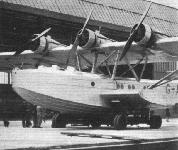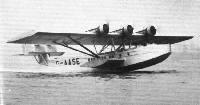
Flight, February 1930
AN AIR YACHT DE LUXE
FLYING has not quite reached the prominence of yachting in the affections of wealthy sportsmen. At least not seaplane flying. So far we have had no Tommy Lipton flying in his own air yacht across the Atlantic to challenge an American defender. But a very good beginning towards that desirable state of affairs was made a couple of years ago, when the Hon. A. E. Guinness bought from the Supermarine Aviation Works the large three-engined flying-boat "Solent." On that machine Mr. Guinness has done a great deal of flying, and has used the "Solent," in addition to shorter cruises on the South Coast, for flights between England and his Irish castle, and for cruises to the Irish lakes. Mr. Guinness is a man who dislikes publicity, and so his use of a flying-boat "air yacht" during the past two years has been much less heard of than could have been desired. A few people directly interested in aviation have known for several months that Mr. Guinness had placed an order with Supermarine's for a new flying-boat, to be used by him as others use their surface yachts; but a promise of secrecy was extracted from those of us who knew of this machine, and not until now has it been possible to refer to it in print. Mr. Guinness has now, fortunately, been persuaded to agree to a few particulars and photographs being published, so that the outside world may learn a little of the rather unusual machine which Supermarine's have designed and built for him.
The new Supermarine "Air Yacht" is of a design differing very materially from all previous Supermarine flying-boats. To begin with, it is a monoplane, the first monoplane built by this firm, apart from the converted "Sparrow" light 'plane. Then, instead of outboard wing floats it has short wing stumps growing out of the hull sides, after the fashion of Dornier flying-boats. This arrangement was almost a logical outcome of the decision to use the monoplane type of wing, as the struts supporting outboard floats from the wings would have had to be rather long. Moreover, the lower wing stumps do undoubtedly, whatever may be their merits in a rough sea provide useful platforms for emplaning and disemplaning passengers with the aid of a launch.
The reproductions of the photographs do not show it, but in the original photographs it can be seen that Mr. Mitchell, Supermarine's chief designer, has gone a step farther than Dr. Dornier (this is not intended as a pun) by providing his wing stumps with shallow steps, so as to extract from them hydrodynamic lift when running, in addition to displacement lift or buoyancy when at rest. It will be interesting to see how this arrangement works in practice. The photographs of the machine running seem to indicate quite exceptional cleanness, but we have not yet had an opportunity of seeing the machine take off, and so do not know whether this absence of thrown-up spray is maintained throughout the whole take-off period.
The wing is supported on struts from the hull, and is braced outboard by sloping Vee struts attached to the lower wing stumps. The three Armstrong-Siddeley geared "Jaguar" engines are mounted direct on the wing and carefully faired, while Townend rings are fitted so as to reduce drag. The structure of the hull and wings is of Duralumin, while highly-stressed fittings are of stainless steel. The wing covering is fabric.
The fuel and oil tanks (sufficient for a range of 2,000 miles if crew only carried) are housed in the wing, a position which will scarcely allow direct gravity feed to be used, but this is a feature common to most monoplane flying-boats. Normally, the machine will not be flown with full tanks, and as a rule the load will be made up of a crew of 3, 6 passengers, and an available load for luggage, etc., of 600 lbs. With this load and fuel to make up a gross weight of 10 1/2 tons, the machine has a range of some 650 miles. The top speed is about 120 m.p.h., and the cruising speed 100 m.p.h. The overall length is 66 ft. 6 in., and the wing span 92 ft.
Below decks the owner's accommodation is very spacious for a flying-boat, with a saloon and cabins, with dressing tables, bookcases, wardrobes, etc. The crew's quarters are forward, under the cockpit. Electric lighting is provided, and the ventilation system includes admission of hot or cold air as required. The galley is fully equipped with oil cooking apparatus so that meals can be prepared on board. Touch with the shore is maintained by means of wireless, both transmitting and receiving apparatus being installed.
- Flight, February 1930
AN AIR YACHT DE LUXE
Фотографии
-
Flight 1930-02 / Flight
Регистрационный номер: G-AASE [15] The New Supermarine Air Yacht: The three Armstrong-Siddeley geared "Jaguar" engines are mounted direct on the wing.
-
Flight 1930-02 / Flight
Регистрационный номер: G-AASE [15] -
Aeroplane Monthly 1982-07 / E.Morgan - Supermarine's Air Yacht
Регистрационный номер: G-AASE [15] The wingless Air Yacht at Woolston in January 1930, shortly before its first flight the following month. Note the name Flying Oma on the nose.
-
Flight 1940-04 / Flight
Регистрационный номер: G-AASE [15] The Air Yacht was bought by the Hon. A. E. Guinness. It is shown with Siddeley Panther engines.
-
Aeroplane Monthly 1982-07 / E.Morgan - Supermarine's Air Yacht
Регистрационный номер: G-AASE [15] The Air Yacht on the Woolston slipway.
-
Flight 1930-02 / Flight
Регистрационный номер: G-AASE [15] The view shows the usefulness of the lower wing stumps as gangway platforms.
-
Flight 1938-08 / Flight Advertisements
Регистрационный номер: G-AASE [15] -
Flight 1938-09 / Flight Advertisements
Регистрационный номер: G-AASE [15] -
Flight 1930-02 / Flight
Регистрационный номер: G-AASE [15] THREE STAGES IN THE TAKE-OFF OF THE SUPERMARINE AIR YACHT: The machine is running slowly.
-
Flight 1930-02 / Flight
Регистрационный номер: G-AASE [15] THREE STAGES IN THE TAKE-OFF OF THE SUPERMARINE AIR YACHT: The machine is gathering way
-
Flight 1931-05 / Flight
Регистрационный номер: G-AASE [15] THREE STAGES IN THE TAKE-OFF OF THE SUPERMARINE AIR YACHT: The the boat is on its step. Clean running characterises all three stages.
-
Flight 1932-10 / Flight
Регистрационный номер: G-AASE [15] "THE LUXURY AIR YACHT": The Supermarine mono-flying-boat, Windward III (3 Armstrong-Siddeley "Panthers"), on which Mrs. J. J. James ,s making a Mediterranean cruise, piloted by Capt. H. C. Biard.
-
Aeroplane Monthly 1982-07 / E.Morgan - Supermarine's Air Yacht
Регистрационный номер: G-AASE [15] The Supermarine Air Yacht in 1932 after its Armstrong Siddeley Jaguar engines had been changed for three 525 h.p. Armstrong Siddeley Panthers.
-
Aeroplane Monthly 1982-07 / E.Morgan - Supermarine's Air Yacht
Регистрационный номер: G-AASE [15] The Air Yacht seen after its purchase by Mrs June Jewett James and renamed Windward III. This view of the Air Yacht shows the enormous wing area and the locations of the crew cockpits forward of the Panther engines.
-
Aeroplane Monthly 1982-07 / E.Morgan - Supermarine's Air Yacht
Регистрационный номер: G-AASE [15] The Air Yacht under construction at Woolston in 1929.
-
Aeroplane Monthly 1982-07 / E.Morgan - Supermarine's Air Yacht
Supermarine 3 engined monoplane flying boat
- Фотографии















